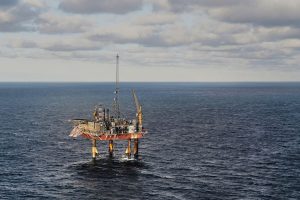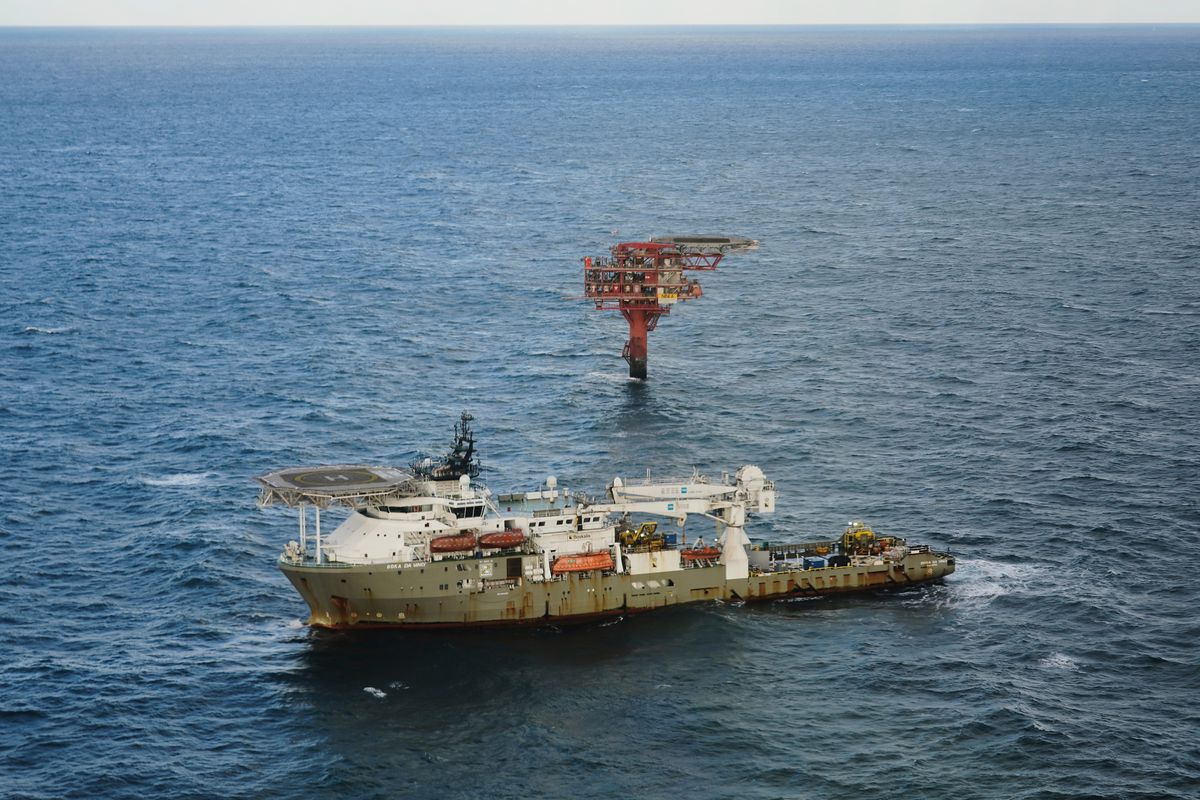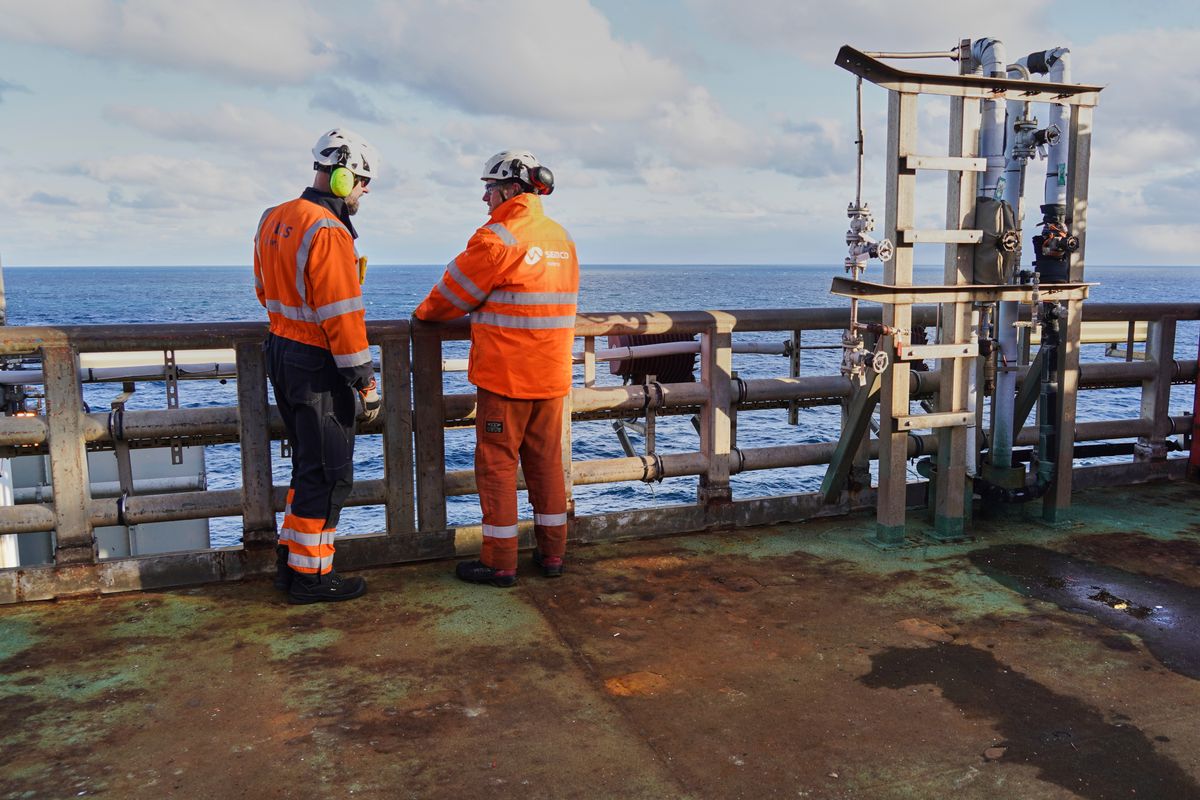NORTH SEA, Denmark (AP) — Appearing first as a dot on the horizon, the remote Nini oil field on Europe’s rugged North Sea slowly comes into view from a helicopter.
Used to extract fossil fuels, the field is now getting a second lease on life as a means of permanently storing planet-warming carbon dioxide beneath the seabed.
In a process that almost reverses oil extraction, chemical giant INEOS plans to inject liquefied CO2 deep down into depleted oil reservoirs, 1,800 meters (5,900 feet) beneath the seabed.
The Associated Press made a rare visit to the Siri platform, close to the unmanned Nini field, the final stage in INEOS’ carbon capture and storage efforts, named Greensand Future.
When the project begins commercial operations next year, Greensand is expected to become the European Union’s first fully-operational offshore CO2 storage site.
Environmentalists say carbon capture and storage, also known as CCS, has a role to play in dealing with climate change but should not be used as an excuse by industries to avoid cutting emissions.
Future plans
Mads Gade, chief executive of INEOS Energy Europe, says it will initially begin storing 400,000 tons (363,000 metric tons) of CO2 per year, scaling up to as much as 8 million tons (7.3 million metric tons) annually by 2030.
“Denmark has the potential to actually store more than several hundred years of our own emissions,” says Gade. “We are able to create an industry where we can support Europe in actually storing a lot of the CO2 here.”
Greensand has struck deals with Danish biogas facilities to bury their captured carbon emissions into the Nini field’s depleted reservoirs.
A “CO2 terminal” that temporarily stores the liquefied gas is being built at the Port of Esbjerg, on the western coast of the Danish Jutland peninsula.
A purpose-built carrier vessel, dubbed “Carbon Destroyer 1,” is under construction in the Netherlands.
Climate solution
Proponents of carbon capture technology say it is a climate solution because it can remove the greenhouse gas that is the biggest driver of climate change and bury it deep underground.
They note the Intergovernmental Panel on Climate Change, the world’s top body of climate scientists, has said the technology is a tool in the fight against global warming.
The EU has proposed developing at least 250 million tons (227 million metric tons) of CO2 storage per year by 2040, as part of plans to reach “net zero” emissions by 2050.
Gade says carbon capture and storage is one of the best means of cutting emissions.
“We don’t want to deindustrialize Europe,” he said. “We want to have actually a few instruments to decarbonize instead.”
Experts at Denmark’s geological survey say Greensand sandstone rock is well-suited for storing the liquefied CO2. Almost a third of the rock volume is made up of tiny cavities, said Niels Schovsbo, senior researcher at the Geological Survey of Denmark and Greenland.
“We found that there (are) no reactions between the reservoir and the injected CO2. And we find that the seal rock on top of that has sufficient capacity to withhold the pressure that is induced when we are storing CO2 in the subsurface,” added Schovsbo.
“These two methods makes it a perfect site for storage right there.”
Limitations and criticism
But while there are many carbon capture facilities around the world, the technology is far from scale, sometimes uses fossil fuel energy in its operations and captures just a tiny fraction of worldwide emissions.
The Greensand project aims to bury up to 8 million tons (7.3 million metric tons) of CO2 a year by 2030. The International Energy Agency says nearly 38 billion tons (34.5 billion metric tons) of CO2 were emitted globally last year.
Environmental campaigners say CCS has been used as an excuse by industries to delay cutting emissions.
“We could have CCS on those very few sectors where emissions are truly difficult or impossible to abate,” said Helene Hagel, head of climate and environmental policy at Greenpeace Denmark.
“But when you have all sectors in society almost saying, we need to just catch the emissions and store them instead of reducing emissions — that is the problem.”
While the chemical giant ramps up carbon storage efforts, it is also hoping to begin development at another previously unopened North Sea oil field.
“The footprint we deliver from importing energy against producing domestic or regional oil and gas is a lot more important for the transition instead of importing with a higher footprint,” said Gade, defending the company’s plans.
“We see a purpose in doing this for a period while we create a transition for Europe.”
___
The Associated Press’ climate and environmental coverage receives financial support from multiple private foundations. AP is solely responsible for all content. Find AP’s standards for working with philanthropies, a list of supporters and funded coverage areas at AP.org.
By JAMES BROOKS
Associated Press





